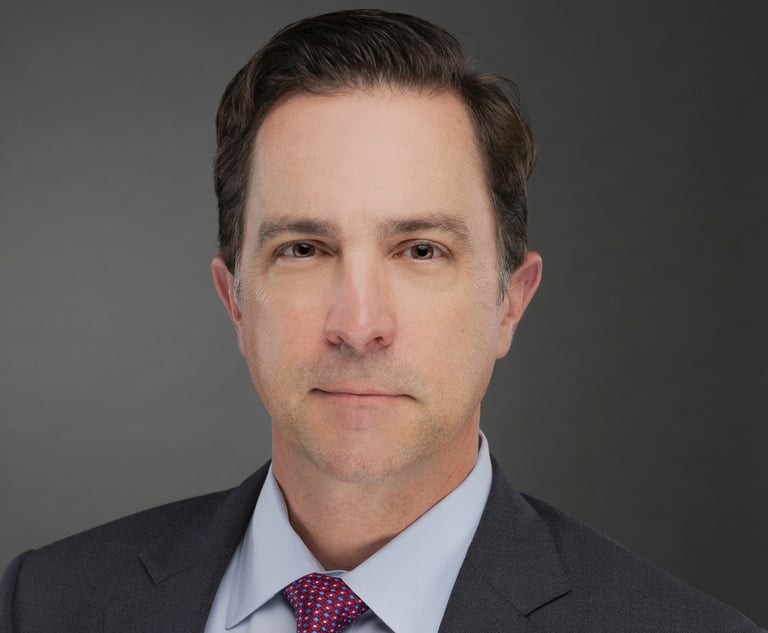Consider This: Nearly Half of the Am Law 200 Have at Least 1 Texas Office
Big firms are moving into Texas at an accelerating pace, with Am Law 200 firms planting 20 flags in Texas in 2018 alone.
November 21, 2019 at 05:00 AM
8 minute read
 The population of Big Law firms with a Texas presence has exploded over the past few decades. (Photo: Roschetzky Photography/Shutterstock.com)
The population of Big Law firms with a Texas presence has exploded over the past few decades. (Photo: Roschetzky Photography/Shutterstock.com)
Big Law firms have been planting flags in Texas since the early 1980s, launching a trend that's accelerated over the decades with Am Law 200 firms currently operating more than 150 offices in the coveted Texas market.
Jones Day, founded more than 100 years ago in Cleveland, may have the oldest Texas office of any Am Law 200 firm not founded in the state. It moved into Texas in 1981 by acquiring Dallas' Meyers Miller Middleton Weiner & Warren, employing an expansion strategy still used today as national and international firms jostle to put down roots in the Lone Star State.
But Jones Day, which was then known as Jones, Day, Reavis & Pogue, wasn't the only out-of-state player in the Texas market in the 1980s. A handful of other Big Law firms also opened shop in Texas during that time frame, including Mayer Brown, Weil, Gotshal & Manges, Gibson, Dunn & Crutcher and Baker McKenzie.
Today, those long-established footholds are just a few in the spray of Big Law offices around Texas. According to data provided by ALM Intelligence, a total of 82 Am Law 200 firms not founded in Texas had at least one office in the state by the end of 2018. All together, those firms have 157 Texas offices, with 4,067 lawyers.
Read More: Which Am Law 200 Firms Have Texas Offices?
During the 1980s, Big Law firms opened six offices in Texas. But in 2018 alone, out-of-state Am Law 200 firms planted 20 offices.
But with office launch activity continuing in 2019, add two more Texas firms to that list—Womble Bond Dickinson, which opened in Houston, and Lathrop Gage, which launched in Dallas.
Firms with an existing Texas presence also expanded their footprints in the state. Phelps Dunbar added an office in Fort Worth, Bradley Arant Boult Cummings opened in Dallas and Reed Smith also opened in Dallas. LeClairRyan opened a new office in Dallas in May, but by August, that firm had voted to dissolve.
A Competitive Market
The long list of out-of-state firms with Texas offices also does not include offices of the five Am Law 100 firms that were founded in Texas, or the four Texas-born firms in the Am Law Second Hundred.
Courtney Marcus, a co-managing partner of Weil's Dallas office, said firms continue to eye Texas because of its diverse corporate base. She attributed "the movement of professionals" and Big Law's "focus on the Texas market" to one simple factor: "our economy."
Houston hosts 65 of the Am Law 200 out-of-state firms' offices, as of late 2019, followed by Dallas with 51 and Austin with 30. The rest of them are spread out among another 10 Texas cities.
Read More: Big Law's Texas Spread
It's not an entirely rosy story—a few firms shuttered offices over the years that couldn't get traction.
Some Texas offices may have been in operation much longer than the data reflects, because of mergers between national firms and Texas firms. Big combinations in 2018, such as Gardere Wynne Sewell with Foley & Lardner (now Foley Gardere in Texas); and Strasburger & Price with Clark Hill (now Clark Hill Strasburger in Texas) are in that category. The Texas offices of those firms are listed in ALM data as opening in 2018 to reflect the time the national firm moved into Texas.
Others in that group include Norton Rose Fulbright, created in the 2013 merger between Texas-based Fulbright & Jaworski and U.K. firm Norton Rose; and some offices of Hunton Andrews Kurth, which formed in 2018 when Virginia firm Hunton & Williams merged with Houston-based Andrews Kurth Kenyon, whose Texas roots dated back to 1902.
Firms Following Clients
Not much has changed over the years in terms of how firms make an entrance in Texas. It's often through a merger or acquisition or by hiring a group of local partners. Sometimes, a firm adds a couple transplants from its other locations.
Terrence Murphy, who joined Jones Day's Dallas office about three years after it opened and helped to build its litigation practice, said Jones Day hit the ground running in that market by merging with a local firm. But it also sent some of its "best and brightest" young partners and senior associates to Texas to help build the practice there.
The legal market was different in those days, Murphy noted. He said most of the firms in Dallas were not large, and the big Houston firms had not yet built large Dallas offices.
"The competition here was merely the local firms. They were good competition. They were very good lawyers, but we didn't have New York or LA firms. They would come later," said Murphy, who is now retired.
Gibson Dunn wasn't far behind Jones Day, opening an outpost in Dallas in 1984. Robert Walters, now partner-in-charge of the office, said the California-based firm launched in Dallas because of its strong relationship with American Airlines, and because of the robust business environment in Dallas with work available for banking, insurance and information systems companies.
Walters, who was at Vinson & Elkins in Houston when Gibson Dunn opened its Dallas office, remembers that the incursion was a topic of discussion at his old firm. He moved to Dallas in 1987 to help launch Vinson & Elkins' Dallas office, and joined Gibson Dunn in 2011 after several years as a general counsel in Dallas.
In Walters' view, hiring "world-class talent" determines whether an out-of-state firm will have success in Texas. If they do, firms can quickly make an impact in the market, he said, pointing to Sidley Austin in Dallas, and Kirkland & Ellis and his firm in Houston.
One key turning point in the market was when Latham & Watkins hired a large group of energy lawyers in Houston in 2010, and Gibson Dunn did the same in Dallas the next year, he said.
"That's when Kirkland got really serious and hired Andy Calder," Walters said, referring to Kirkland's establishment of a Houston office in 2014 led by Calder, a partner and member of the firm's global management committee.
Weil also moved into Dallas in 1987 because of a client. Hiring lateral partner Glenn West and now-retired partner Bob Feldman, the New York-based firm launched the office to do work for J.C. Penney, which moved its headquarters to Texas, Marcus said. Two years earlier, the firm had established an office in Houston.
Fairly quickly—due in part to the stock market crash in 1987—Weil built a private equity practice, Marcus said. The crash also created bankruptcy work in Dallas and Houston, some of it oil and gas related, she noted.
Energy work brought Mayer Brown to Texas. Kevin Shaw joined Mayer Brown shortly after it opened a Houston office in 1982 to work with banking clients on energy deals. The office capitalized on the energy boom, he said, and then after the mid-1980s bust, lawyers transitioned to workouts.
"It was a pretty grim time, but we stayed pretty busy," he said.
Shaw, now a senior counsel who splits his time between Houston and Los Angeles, said the Houston market was a challenging one to break into for out-of-state firms in the early 1980s.
"The good-old-boy and Yankee-go-home stuff was a lot more of a factor then. Houston was much less diverse, less cosmopolitan, kind of old-school. There was a lot more hostility toward the out-of-town firms," he said.
The Texas lateral market is exceptionally active today, but that wasn't the case in the 1980s, according to Shaw, who said lawyers needed a lot of convincing to make lateral moves. But he's not at all surprised that so many firms have opened offices in Texas over the last couple of years.
"The forces are the same. You have this pot-of-gold legal market," he said.
Read More
This content has been archived. It is available through our partners, LexisNexis® and Bloomberg Law.
To view this content, please continue to their sites.
Not a Lexis Subscriber?
Subscribe Now
Not a Bloomberg Law Subscriber?
Subscribe Now
NOT FOR REPRINT
© 2025 ALM Global, LLC, All Rights Reserved. Request academic re-use from www.copyright.com. All other uses, submit a request to [email protected]. For more information visit Asset & Logo Licensing.
You Might Like
View All
O'Melveny, White & Case, Skadden Beef Up in Texas With Energy, Real Estate Lateral Partner Hires
5 minute read
Chamberlain Hrdlicka Taps a New Leader as Firm Follows Succession Planning Path
3 minute read
Law Firms Are 'Struggling' With Partner Pay Segmentation, as Top Rainmakers Bring In More Revenue
5 minute read
Trending Stories
- 1Decision of the Day: Trial Court's Sidestep of 'Batson' Deprived Defendant of Challenge to Jury Discrimination
- 2Is Your Law Firm Growing Fast Enough? Scale, Consolidation and Competition
- 3Child Custody: The Dangers of 'Rules of Thumb'
- 4The Spectacle of Rudy Giuliani Returns to the SDNY
- 5Orrick Hires Longtime Weil Partner as New Head of Antitrust Litigation
Who Got The Work
J. Brugh Lower of Gibbons has entered an appearance for industrial equipment supplier Devco Corporation in a pending trademark infringement lawsuit. The suit, accusing the defendant of selling knock-off Graco products, was filed Dec. 18 in New Jersey District Court by Rivkin Radler on behalf of Graco Inc. and Graco Minnesota. The case, assigned to U.S. District Judge Zahid N. Quraishi, is 3:24-cv-11294, Graco Inc. et al v. Devco Corporation.
Who Got The Work
Rebecca Maller-Stein and Kent A. Yalowitz of Arnold & Porter Kaye Scholer have entered their appearances for Hanaco Venture Capital and its executives, Lior Prosor and David Frankel, in a pending securities lawsuit. The action, filed on Dec. 24 in New York Southern District Court by Zell, Aron & Co. on behalf of Goldeneye Advisors, accuses the defendants of negligently and fraudulently managing the plaintiff's $1 million investment. The case, assigned to U.S. District Judge Vernon S. Broderick, is 1:24-cv-09918, Goldeneye Advisors, LLC v. Hanaco Venture Capital, Ltd. et al.
Who Got The Work
Attorneys from A&O Shearman has stepped in as defense counsel for Toronto-Dominion Bank and other defendants in a pending securities class action. The suit, filed Dec. 11 in New York Southern District Court by Bleichmar Fonti & Auld, accuses the defendants of concealing the bank's 'pervasive' deficiencies in regards to its compliance with the Bank Secrecy Act and the quality of its anti-money laundering controls. The case, assigned to U.S. District Judge Arun Subramanian, is 1:24-cv-09445, Gonzalez v. The Toronto-Dominion Bank et al.
Who Got The Work
Crown Castle International, a Pennsylvania company providing shared communications infrastructure, has turned to Luke D. Wolf of Gordon Rees Scully Mansukhani to fend off a pending breach-of-contract lawsuit. The court action, filed Nov. 25 in Michigan Eastern District Court by Hooper Hathaway PC on behalf of The Town Residences LLC, accuses Crown Castle of failing to transfer approximately $30,000 in utility payments from T-Mobile in breach of a roof-top lease and assignment agreement. The case, assigned to U.S. District Judge Susan K. Declercq, is 2:24-cv-13131, The Town Residences LLC v. T-Mobile US, Inc. et al.
Who Got The Work
Wilfred P. Coronato and Daniel M. Schwartz of McCarter & English have stepped in as defense counsel to Electrolux Home Products Inc. in a pending product liability lawsuit. The court action, filed Nov. 26 in New York Eastern District Court by Poulos Lopiccolo PC and Nagel Rice LLP on behalf of David Stern, alleges that the defendant's refrigerators’ drawers and shelving repeatedly break and fall apart within months after purchase. The case, assigned to U.S. District Judge Joan M. Azrack, is 2:24-cv-08204, Stern v. Electrolux Home Products, Inc.
Featured Firms
Law Offices of Gary Martin Hays & Associates, P.C.
(470) 294-1674
Law Offices of Mark E. Salomone
(857) 444-6468
Smith & Hassler
(713) 739-1250






